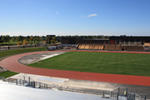
Features
Profiles
IAAF demands stringent conditions for newly-constructed field in Moncton
March 30, 2010 By Mike Jiggens
MONCTON, N.B. is fast becoming the home of some of Canada’s finest
sports facilities. This summer, about 1,500 athletes from around the
world will see first-hand what the city has to offer.
From July 19-25, the city will play host to the International Association of Athletics Federations (IAAF) World Junior Track and Field Championships. Many of the 19-years-and-younger athletes, who will be representing 170 countries from around the globe, are expected to compete at the 2012 Summer Olympics in London, England. 
The site for the championships is a brand new, multi-purpose stadium built last year on the campus of the Université de Moncton (UDM). The multi-million-dollar stadium was jointly funded by the university, the federal and provincial governments, and the city.
The state-of-the-art facility features a grass infield, an eight-lane track, and locations for jumping and throwing events.
Project manager for the stadium was Bob Daniels, a retired professor from Nova Scotia Agricultural College’s department of environmental sciences, while Gorden Horsman, supervisor of Class A fields for the City of Moncton, has been given the responsibility of ensuring the field meets the stringent standards set by the IAAF.
“My role in this will now be to work with Bob to get it ready for the world junior championships,” Horsman said.
Coming on board in early September 2009, once construction was complete, Horsman’s task was to fertilize, topdress, aerate and “do everything necessary” to get the field ready for winter. Once spring arrives, he’ll provide the care it needs to ensure everything is ready for July and that it meets the expected standard.
“It’s going to be a challenge,” he said. “Every aspect of it has to be camera-ready by July. When they (IAAF) say camera-ready, they mean camera-ready. Everything has to blend in. The turf has to look the same on the outside area as it does in the track area.”
The tolerances for the field, as set by the IAAF, are “unbelievable,” Horsman said, noting that elevation-wise, there is to be a one-millimetre-over-20-metres deviation.
An IAAF official is scheduled to visit the facility this spring to ensure the exact specifications are met. Every aspect of both the competition area and its infrastructure will be carefully inspected. Horsman said the stadium luminosity must attain a certain number of candles, each blade of grass is to be cut at precisely one inch for the games, and the track must drain within a specified time period.
Horsman said he has previously met the IAAF official who will be visiting the site, “and he’s not bashful. If he sees something wrong, he’ll say, ‘I want that fixed.’ And it gets fixed.”
Staff working for Horsman have undergone specialized training the past couple of years to ensure maintenance of the field is in compliance with IAAF specifications. Additional city staff have been hired to prepare the UDM field for the world championships, and Horsman said he expects to be joined by a number of university staff as well.
Construction of the infield allowed for the possibility of it being converted to an artificial surface at a later date. Grading of its sub-base and the addition of drainage gravel were done to accommodate an artificial turf covering.
The sand-based infield’s root zone is 10 inches deep. It was seeded to a blend of 90 per cent Kentucky bluegrass and 10 per cent perennial ryegrass in the fall of 2008, but a delay in the construction of the field’s drainage system forced seeding to be delayed beyond the intended Sept. 15 date.
It was deemed seeding could be done safely beyond that date only if temperatures could exceed 12 degrees Celsius for up to 10 days. By Sept. 26, favourable weather was forecast and the infield was seeded at a rate of four pounds per 1,000 square feet. The warmer conditions were necessary to ensure optimum germination. A heavier seeding rate was used to improve the germination rate in the event temperatures were to drop below optimum. The warm weather was complemented by ample rainfall during the course of a two-week period.
The perennial ryegrass emerged in seven days and the Kentucky bluegrass five days later. At the end of November, the Kentucky bluegrass seedlings had grown to a height of 11/4 inches and had developed a healthy root system.
Practices areas were sodded in late 2009.
The infield’s D zones—the rounded ends just inside the track yet outside the rectangular infield—are to be constructed with a synthetic surface geared toward events in which proper traction is required. The surface will prevent slippage among athletes engaged in throwing events such as the javelin and discus.
Events such as the triple and long jumps will take place between the perimeter track and the spectator seating area. This was planned so that the infield could remain wide enough to comply with FIFA rules for international soccer games.
Horsman’s work on the field won’t be over at the conclusion of the track and field championships. In September, a neutral site Canadian Football League game, between the Toronto Argonauts and the Edmonton Eskimos, will be played at the stadium. To accommodate football, synthetic turf will be installed in the D zones. The converted D zones will become the football field’s end zones. Upright goals will also have to be installed.
Print this page